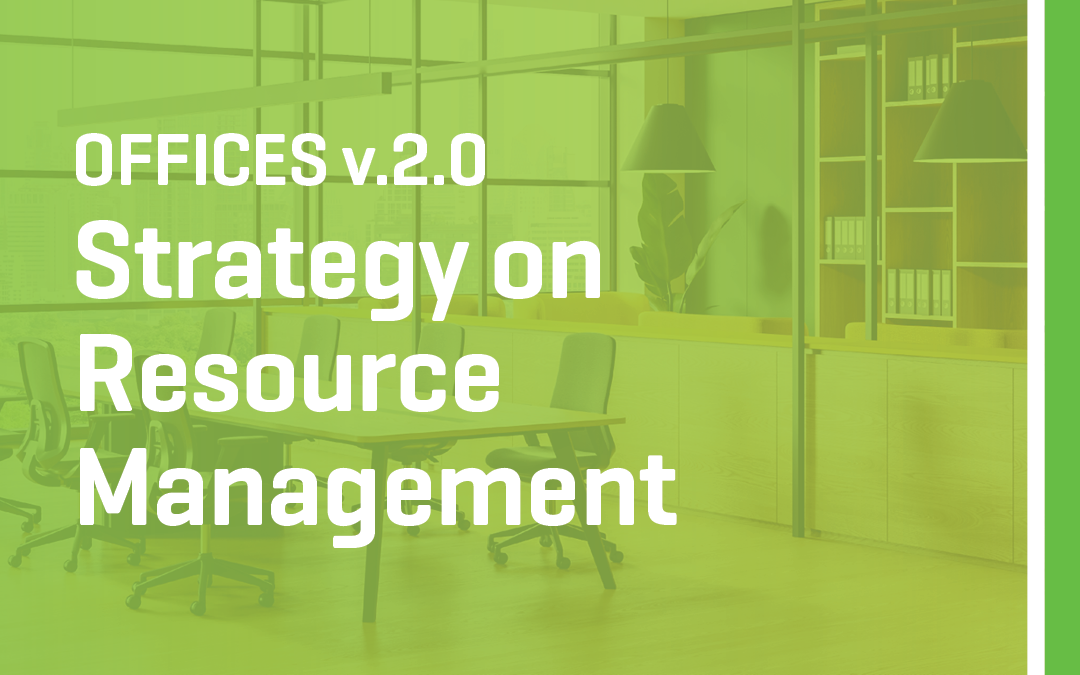This is a technical note relating to the Offices v2.0 scheme update and forms part of a series of related technical articles. To read the previous post on Energy & CO2 please follow this link, and to read the post on Materials & Ecology please follow this link.
SKArating is stepping up its approach to resource management with significant updates that prioritise reuse, traceability, and shared responsibility across the supply chain and supply cycle. This change is also demonstrated by the category renaming from ‘Waste’ to ‘Resource Management’.
The standout shift? A firm requirement for design for disassembly and traceability. Every product or material must now be removable without contamination, and installed or moved on with data traceability, enabling safe future reuse. Reused materials must also come with circularity data or if possible a material/product passport to ensure traceability and performance integrity.
The revised Resource Management measures also introduce new benchmarks for levels of circularity, following the trajectory started in the Higher Education scheme in 2016. These benchmarks are drawn from high performing products, from supply chain sector performance and the elements’ nature and features themselves, aligning ambition with achievability for good practice levels.
Data can support circularity and increase safety and performance. It is recognised that in non-integrated projects or projects and teams where new process systems are being introduced, this is likely to add resource to current businesses and project sizes. This change is a forward investment for clients, suppliers and nations and ensure we start retaining more of the value created in fixed assets.
Together, these changes represent a more systemic, practical and data-driven scheme — one that builds confidence, reduces greenwashing, and helps the industry and market move forward with purpose.
A joined up and practical approach – RMPT process
The refinement of the RMPs (now RMPTs) and SWMP documents and processes is the most notable starting point for the category. The Resource Management Plans are now refined to act as a wider umbrella process that focuses on the active planning of assets onto or off the site, and helping teams track, manage and measure. The measure is removing the need to create long word generic documents that are not helping teams actively in project decisions, to a predominantly schedule-based tracker which includes planning decisions specific to each item. The start of the resource management planning at the design stage, and the need for updates along key project milestones by respective teams, is also another key change that will support the original aims for this measure and the overall category.
The renaming of the title to add the word ‘Tracker’ is done to highlight the actively tracking focused nature of this measure rather than it being a word document that few refer to. At least, we hope so as this issue needs support based on past project demonstrations.
Resource management begins right at the start of the project, before design starts. The introduction of the pre-refurbishment survey into the Offices scheme aims to inform design teams of the resource they have available as soon as they on-board the project. The role of dilapidations must not be sidelined and it is hoped that pre-refurbishment surveys can form part of this asset stage in the very near future and link-up with resource management.
Whole life and In Use scheme drivers
The re-named and updated ‘D60 Designing out Waste’ measure to now focus on whole life thinking and optimising the resource’s use as long as possible, also aligns with the SKArating strategic direction to include whole life thinking of projects. The lift of the aims for this measure from reducing waste to increasing circularity is also reflecting the lift of benchmarks and performance to reflect current good practice.
Of note is the new measure ‘D84 Fixed asset tagging register’ which looks to take part in the relay of information from the project delivery team to the facilities/asset management team and then onto the next project team or material supplier or processor. Projects are gathering a mine of information during the design and delivery stage on products and materials and this does not find its way forwards, or forwards in an accessible and tagged way. It is hoped this is the first step to support product passports and fixed assets becoming the norm and retaining for longer the resource value.
A Systemic approach
The resource management measures are part of a system of steps, some of which are also found in the Materials and Project Delivery categories. For example;
- Materials measures start with the requirement for disassembly before they move onto the additional criteria to be achieved.
- The Project Delivery new measure ‘D88 Project Delivery Programme’ looks to raise the issue of time and project sequencing to enable the systemic changes that support circular economy and resource management in practice.
The Offices v2.0 Public Consultation is now open, find out more and how to provide feedback below.

